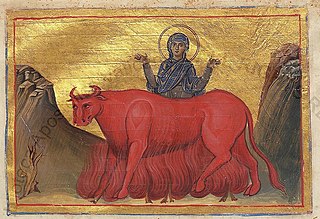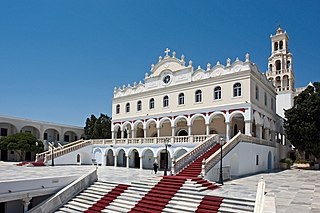See also
- Pelageya, а Russian singer
- Pelageya (disambiguation)
- Marina (disambiguation), the Latinized form of Pelagia
Saint Pelagia , Pelagia of Antioch, Pelagia the Penitent or Pelagia the Harlot was a legendary Christian saint and hermit in the 4th or 5th century.
Pelagia may also refer to:

Year 320 (CCCXX) was a leap year starting on Friday of the Julian calendar. At the time, it was known as the Year of the Consulship of Constantinus and Constantinus. The denomination 320 for this year has been used since the early medieval period, when the Anno Domini calendar era became the prevalent method in Europe for naming years.

Margaret, known as Margaret of Antioch in the West, and as Saint Marina the Great Martyr in the East, is celebrated as a saint on 20 July in the Western Rite Orthodoxy, Roman Catholic Church and Anglicanism, on 17 July by the Eastern Orthodox Church and on Epip 23 and Hathor 23 in the Coptic Orthodox Church of Alexandria.
Ignatius is a male given name and a surname. Notable people with the name include:
Achilles is the name of a Greek mythological hero of the Trojan War.
Eudoxia, Eudokia or Evdokia is a feminine given name, which originally meant "good fame or judgement" or "she whose fame or judgement is good" in Greek. The Slavic forms of the name are East Slavic: Evdokiya, Yevdokiya ; South Slavic: Evdokija (Евдокија), Jevdokija (Јевдокија). It was mainly popular in late antiquity and during the Middle Ages, particularly in Eastern Europe. It continues to be in use today, usually in honor of various saints.

July 16 - Eastern Orthodox Church calendar - July 18

Pelagia, distinguished as Pelagia of Antioch, Pelagia the Penitent, and Pelagia the Harlot, was a Christian saint and hermit in the 4th or 5th century. Her feast day was celebrated on 8 October, originally in common with Saints Pelagia the Virgin and Pelagia of Tarsus. Pelagia died as a result of extreme asceticism, which had emaciated her to the point she could no longer be recognized. According to Orthodox tradition, she was buried in her cell. Upon the discovery that the renowned monk had been a woman, the holy fathers tried to keep it a secret, but the gossip spread and her relics drew pilgrims from as far off as Jericho and the Jordan valley.

October 6 - Eastern Orthodox liturgical calendar - October 8

October 7 - Eastern Orthodox liturgical calendar - October 9

October 19 - Eastern Orthodox liturgical calendar - October 21

January 29 - Eastern Orthodox liturgical calendar - January 31

Pelagia noctiluca is a jellyfish in the family Pelagiidae and the only currently recognized species in the genus Pelagia. It is typically known in English as the mauve stinger, but other common names are purple-striped jelly, purple stinger, purple people eater, purple jellyfish, luminous jellyfish and night-light jellyfish. In Greek, pelagia means "(she) of the sea", from pelagos "sea, open sea"; in Latin noctiluca is the combining form of nox, "night"", and lux, "light"; thus, Pelagia noctiluca can be described as a marine organism with the ability to glow in the dark (bioluminescence). It is found worldwide in tropical and warm temperate seas, although it is suspected that records outside the North Atlantic region, which includes the Mediterranean and Gulf of Mexico, represent closely related but currently unrecognized species.

Nonnus was legendary 4th- or 5th-century Christian saint, said to have been an Egyptian monk who became a bishop in Syria and was responsible for the conversion of St Pelagia the harlot during one of the Synods of Antioch. His feast day is observed on November 10.

Pelagia, distinguished as Pelagia of Tarsus and Pelagia the Martyr, was a legendary Christian saint and martyr who lived in Tarsus in Cilicia during the reign of Roman emperor Diocletian. Originally, her feast day was celebrated on October 8, in common with SS Pelagia the Virgin & Pelagia the Harlot, both of Antioch and one or both of whom her story is probably modeled after.
Thecla, Tecla, or its variants is a Greek feminine given name made famous by Saint Thecla, a 1st-century Christian martyr.

Our Lady of Tinos is the major Marian shrine in Greece. It is located in the town of Tinos on the island of Tinos.

The title Virgin is an honorific bestowed on female saints and blesseds in some Christian traditions, including the Eastern Orthodox Church and the Catholic Church.
Pelageya Sergeyevna Khanova is а Russian singer.
Pelagia, distinguished as Pelagia of Antioch and Pelagia the Virgin, was a Christian saint, virgin, and martyr who leapt to her death during the Diocletianic Persecution rather than be forced by Roman soldiers to offer a public sacrifice to the pagan gods, or to do "something unspeakable ", typically inferred as the Roman soldiers attempting to rape her. She was 15 years old. Originally, her feast day was celebrated on October 8, in common with SS Pelagia the Harlot and Pelagia of Tarsus. In the Roman Catholic Church, it came to be celebrated on June 9 and, at Naples in Italy, she is celebrated on October 5.
Januarius and Pelagia were joint Christian martyrs and saints recorded in the Jerusalem Martyrology. They were beheaded or racked and torn with iron claws and pieces of earthware at Nicopolis in Armenia during the reign of the Roman emperor Licinius. Their feast day observed on July 11. They are possibly to be considered identical with SS Januarius and Marinus who were martyred in the same place in the same year under identical circumstances with the martyrs Nabor and Felix; their feast day, however, was observed on July 10. Alternatively, the quartet may have been a combination of Januarius and Pelagia with the SS Nabor and Felix were martyred in Italy in the early 4th century.